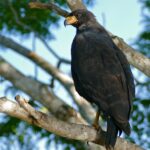The great black hawk and the great horned owl are two of the most formidable predators in their respective habitats. While they share some similarities, they also have distinct differences in their physical characteristics, hunting strategies, and prey preferences.
Physical Differences
The great horned owl (Bubo virginianus) is a large, powerful bird with a wingspan of up to 5 feet and a body length of up to 2 feet. It has distinctive ear-like tufts on its head, yellow eyes, and a broad, rounded face. Its plumage can range from light to dark brown with white spots and streaks.
In contrast, the great black hawk (Buteogallus urubitinga) is a medium-sized bird of prey with a wingspan of up to 4 feet and a body length of up to 2 feet. It has a striking black plumage with white streaks on its wings and tail, and a yellow cere (the fleshy part above the beak).
Hunting Strategies
 Image source: Great Black Hawk by Bernard DUPONT
Image source: Great Black Hawk by Bernard DUPONT
The great horned owl is a nocturnal hunter, relying on its keen eyesight and hearing to locate and capture prey. It hunts from a perch, swooping down on its prey with its talons extended. It is an opportunistic feeder, taking a wide range of prey including mammals, birds, reptiles, and insects.
The great black hawk, on the other hand, is a diurnal hunter, active during the day and early evening. It hunts by soaring over open areas or perching on a high vantage point and scanning for prey. It is a skilled flier and can hover in place, making it an effective hunter of small mammals, birds, and reptiles.
Prey Preferences
The great horned owl is a generalist predator, taking a wide range of prey. Its diet includes rodents, rabbits, hares, squirrels, raccoons, opossums, bats, and birds, including other raptors. It has been known to take prey as large as great blue herons and Canada geese.
The great black hawk, on the other hand, is also a generalist predator, but it tends to specialize in hunting small mammals and birds. Its diet includes rats, mice, bats, and birds, as well as reptiles and amphibians.
Hunting Abilities
In terms of their hunting abilities, the great horned owl is a powerful and versatile predator that can take down prey much larger than itself. It is a skilled hunter with a wide range of prey, from small rodents to large birds.
The great black hawk is also a formidable hunter, but it tends to specialize in smaller prey. Its aerial skills and ability to hover make it an effective hunter of small mammals and birds.
Conclusion
While both the great horned owl and the great black hawk are powerful predators, they have distinct differences in their physical characteristics, hunting strategies, and prey preferences. The great horned owl is a nocturnal hunter with a wide range of prey, while the great black hawk is a diurnal hunter that specializes in smaller prey. Ultimately, both species play important roles in maintaining the balance of their respective ecosystems.


